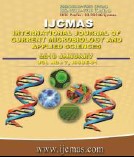


 National Academy of Agricultural Sciences (NAAS)
National Academy of Agricultural Sciences (NAAS)

|
PRINT ISSN : 2319-7692
Online ISSN : 2319-7706 Issues : 12 per year Publisher : Excellent Publishers Email : editorijcmas@gmail.com / submit@ijcmas.com Editor-in-chief: Dr.M.Prakash Index Copernicus ICV 2018: 95.39 NAAS RATING 2020: 5.38 |
Pig has a great potential to contribute to better economic return to the farmers. A balanced diet having proper ratio of energy and protein need to be prepared to make the pig farming economical. The present study was carried out on over 30 growing three months old crossbred piglets to evaluate the energy and protein requirement in growing and finishing pigs. Accordingly, five diets were prepared viz. T1 (Medium energy (75%) and medium protein diet (18%); T2 (Medium energy (75%) and low protein diet (16.20); T3 (Low energy (67.50 %) and high protein diet (19.80%); T4 (Low energy (67.50%) and medium protein diet (18%) and T5 (Low energy (67.50%) and Low protein diet (16.20%). The average daily body weight gains, feed efficiency in the piglets fed on different experimental groups was calculated. Differences among the groups were observed to be statistically non-significant, yet the rate of gains decreased with decrease of energy and protein levels in their rations notably in the T5 group. Similarly, cost per kilo gram edible meat was observed to lowest in T1 (93.68Rs.), followed by T2 (95.87 Rs.), T3 (97.91Rs.), T4 (98.61 Rs.), and T5 (98.61 Rs.), respectively. The differences in costs incurred on one kg gain in body weight were found to be statistically non- significant.
 |
 |
 |
 |
 |